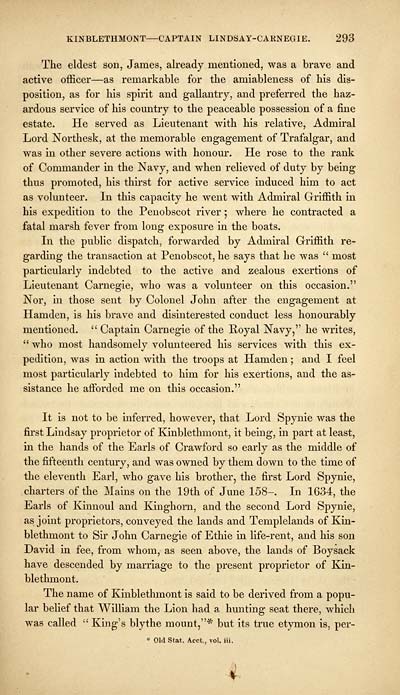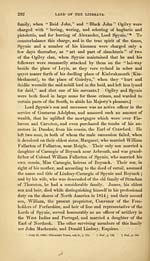Download files
Complete book:
Individual page:
Thumbnail gallery: Grid view | List view

KINBLETHMONT — CAPTAIN LINDSAY-CAKNEGIE. 293
The eldest son, James, already mentioned, was a brave and
active officer — as remarkable for the amiableness of his dis-
position, as for his spirit and gallantry, and preferred the haz-
ardous service of his country to the peaceable possession of a fine
estate. He served as Lieutenant with his relative, Admiral
Lord Northesk, at the memorable engagement of Trafalgar, and
was in other severe actions with honour. He rose to the rank
of Commander in the Navy, and when relieved of duty by being
thus promoted, his thirst for active service induced him to act
as volunteer. In this capacity he went with Admiral Griffith in
his expedition to the Penobscot river ; where he contracted a
fatal marsh fever from long exposure in the boats.
In the public dispatch, forwarded by Admiral Griffith re-
garding the transaction at Penobscot, he says that he was " most
particularly indebted to the active and zealous exertions of
Lieutenant Carnegie, who was a volunteer on this occasion."
Nor, in those sent by Colonel John after the engagement at
Hamden, is his brave and disinterested conduct less honourably
mentioned. " Captain Carnegie of the Royal Navy," he writes,
" who most handsomely volunteered his services with this ex-
pedition, was in action with the troops at Hamden ; and I feel
most particularly indebted to him for his exertions, and the as-
sistance he afforded me on this occasion."
It is not to be inferred, however, that Lord Spynie was the
first Lindsay proprietor of Kinblethmont, it being, in part at least,
in the hands of the Earls of Crawford so early as the middle of
the fifteenth century, and was owned by them down to the time of
the eleventh Earl, who gave his brother, the first Lord Spynie,
charters of the Mains on the 19th of June 158-. In 1634, the
Earls of Kinnoul and Kinghom, and the second Lord Spynie,
as joint proprietors, conveyed the lands and Templelands of Kin-
blethmont to Sir John Carnegie of Ethie in life-rent, and his son
David in fee, from whom, as seen above, the lands of Boysack
have descended by marriage to the present proprietor of Kin-
blethmont.
The name of Kinblethmont is said to be derived from a popu-
lar belief that William the Lion had a hunting seat there, which
was called " King's blythe mount,"* but its true etymon is, per-
* Old Stat. Aect., vol. iii.
The eldest son, James, already mentioned, was a brave and
active officer — as remarkable for the amiableness of his dis-
position, as for his spirit and gallantry, and preferred the haz-
ardous service of his country to the peaceable possession of a fine
estate. He served as Lieutenant with his relative, Admiral
Lord Northesk, at the memorable engagement of Trafalgar, and
was in other severe actions with honour. He rose to the rank
of Commander in the Navy, and when relieved of duty by being
thus promoted, his thirst for active service induced him to act
as volunteer. In this capacity he went with Admiral Griffith in
his expedition to the Penobscot river ; where he contracted a
fatal marsh fever from long exposure in the boats.
In the public dispatch, forwarded by Admiral Griffith re-
garding the transaction at Penobscot, he says that he was " most
particularly indebted to the active and zealous exertions of
Lieutenant Carnegie, who was a volunteer on this occasion."
Nor, in those sent by Colonel John after the engagement at
Hamden, is his brave and disinterested conduct less honourably
mentioned. " Captain Carnegie of the Royal Navy," he writes,
" who most handsomely volunteered his services with this ex-
pedition, was in action with the troops at Hamden ; and I feel
most particularly indebted to him for his exertions, and the as-
sistance he afforded me on this occasion."
It is not to be inferred, however, that Lord Spynie was the
first Lindsay proprietor of Kinblethmont, it being, in part at least,
in the hands of the Earls of Crawford so early as the middle of
the fifteenth century, and was owned by them down to the time of
the eleventh Earl, who gave his brother, the first Lord Spynie,
charters of the Mains on the 19th of June 158-. In 1634, the
Earls of Kinnoul and Kinghom, and the second Lord Spynie,
as joint proprietors, conveyed the lands and Templelands of Kin-
blethmont to Sir John Carnegie of Ethie in life-rent, and his son
David in fee, from whom, as seen above, the lands of Boysack
have descended by marriage to the present proprietor of Kin-
blethmont.
The name of Kinblethmont is said to be derived from a popu-
lar belief that William the Lion had a hunting seat there, which
was called " King's blythe mount,"* but its true etymon is, per-
* Old Stat. Aect., vol. iii.
Set display mode to:
![]() Universal Viewer |
Universal Viewer | ![]() Mirador |
Large image | Transcription
Mirador |
Large image | Transcription
Images and transcriptions on this page, including medium image downloads, may be used under the Creative Commons Attribution 4.0 International Licence unless otherwise stated. ![]()
| Histories of Scottish families > History and traditions of the land of the Lindsays in Angus and Mearns > (311) Page 293 |
|---|
| Permanent URL | https://digital.nls.uk/94872758 |
|---|
| Description | A selection of almost 400 printed items relating to the history of Scottish families, mostly dating from the 19th and early 20th centuries. Includes memoirs, genealogies and clan histories, with a few produced by emigrant families. The earliest family history goes back to AD 916. |
|---|

